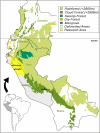Traditional medicinal plant use in Northern Peru: tracking two thousand years of healing culture
- PMID: 17090303
- PMCID: PMC1637095
- DOI: 10.1186/1746-4269-2-47
Traditional medicinal plant use in Northern Peru: tracking two thousand years of healing culture
Abstract
This paper examines the traditional use of medicinal plants in Northern Peru, with special focus on the Departments of Piura, Lambayeque, La Libertad, Cajamarca, and San Martin. Northern Peru represents the center of the old Central Andean "Health Axis," stretching from Ecuador to Bolivia. The roots of traditional healing practices in this region go at least as far back as the Moche period (AC 100-800). Although about 50% of the plants in use reported in the colonial period have disappeared from the popular pharmacopoeia, the plant knowledge of the population is much more extensive than in other parts of the Andean region. 510 plant species used for medicinal purposes were collected, identified and their vernacular names, traditional uses and applications recorded. The families best represented were Asteraceae with 69 species, Fabaceae (35), Lamiaceae (25), and Solanaceae (21). Euphorbiaceae had twelve species, and Apiaceae and Poaceae 11 species. The highest number of species was used for the treatment of "magical/ritual" ailments (207 species), followed by respiratory disorders (95), problems of the urinary tract (85), infections of female organs (66), liver ailments (61), inflammations (59), stomach problems (51) and rheumatism (45). Most of the plants used (83%) were native to Peru. Fresh plants, often collected wild, were used in two thirds of all cases, and the most common applications included the ingestion of herb decoctions or the application of plant material as poultices.
Figures




Similar articles
-
Shadows of the colonial past--diverging plant use in Northern Peru and Southern Ecuador.J Ethnobiol Ethnomed. 2009 Feb 2;5:4. doi: 10.1186/1746-4269-5-4. J Ethnobiol Ethnomed. 2009. PMID: 19187546 Free PMC article.
-
Traditional medicinal plant use in Loja province, Southern Ecuador.J Ethnobiol Ethnomed. 2006 Oct 10;2:44. doi: 10.1186/1746-4269-2-44. J Ethnobiol Ethnomed. 2006. PMID: 17032450 Free PMC article.
-
Ethnomedicinal survey of a maroon community in Brazil's Atlantic tropical forest.J Ethnopharmacol. 2016 Apr 2;181:37-49. doi: 10.1016/j.jep.2016.01.014. Epub 2016 Jan 21. J Ethnopharmacol. 2016. PMID: 26802786
-
An ethnobotanical survey of medicinal plants commercialized in the markets of La Paz and El Alto, Bolivia.J Ethnopharmacol. 2005 Feb 28;97(2):337-50. doi: 10.1016/j.jep.2004.11.022. J Ethnopharmacol. 2005. PMID: 15707774 Review.
-
The globalization of traditional medicine in northern peru: from shamanism to molecules.Evid Based Complement Alternat Med. 2013;2013:291903. doi: 10.1155/2013/291903. Epub 2013 Dec 28. Evid Based Complement Alternat Med. 2013. PMID: 24454490 Free PMC article. Review.
Cited by
-
A comparative ethnobotany of Khevsureti, Samtskhe-Javakheti, Tusheti, Svaneti, and Racha-Lechkhumi, Republic of Georgia (Sakartvelo), Caucasus.J Ethnobiol Ethnomed. 2016 Sep 21;12(1):43. doi: 10.1186/s13002-016-0110-2. J Ethnobiol Ethnomed. 2016. PMID: 27659258 Free PMC article.
-
Herbal mixtures in traditional medicine in Northern Peru.J Ethnobiol Ethnomed. 2010 Mar 14;6:10. doi: 10.1186/1746-4269-6-10. J Ethnobiol Ethnomed. 2010. PMID: 20226092 Free PMC article.
-
Astonishing diversity-the medicinal plant markets of Bogotá, Colombia.J Ethnobiol Ethnomed. 2018 Jun 20;14(1):43. doi: 10.1186/s13002-018-0241-8. J Ethnobiol Ethnomed. 2018. PMID: 29925407 Free PMC article.
-
Prevalence and determinants of cardiovascular disease risk factors using the WHO STEPS approach in Cochabamba, Bolivia.BMC Public Health. 2019 Jun 20;19(1):786. doi: 10.1186/s12889-019-7064-y. BMC Public Health. 2019. PMID: 31221119 Free PMC article.
-
The Ethnobotany and Chemistry of South African Meliaceae: A Review.Plants (Basel). 2021 Aug 28;10(9):1796. doi: 10.3390/plants10091796. Plants (Basel). 2021. PMID: 34579329 Free PMC article. Review.
References
-
- World Health Organization . WHO Traditional Medicine Strategy 2002–2005. World Health Organization, Geneva; 2002.
-
- World Health Organization . Consultation Meeting on Traditional Medicine and Modern Medicine: Harmonizing the Two Approaches. Geneva, World Health Organization; 1999. (document reference (WP)TM/ICP/TM/001/RB/98- RS/99/GE/32(CHN))
-
- World Health Organization . Traditional, Complementary and Alternative Medicines and Therapies. Washington DC, WHO Regional Office for the Americas/Pan American Health Organization (Working group OPS/OMS); 1999.
-
- World Health Organization . Report: Technical Briefing on Traditional Medicine Forty-ninth Regional Committee Meeting, Manila, Philippines, 18 September 1998. Manila, WHO Regional Office for the Western Pacific; 1998.
Publication types
MeSH terms
Substances
Grants and funding
LinkOut - more resources
Full Text Sources
Other Literature Sources

